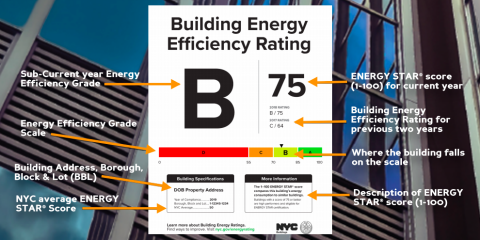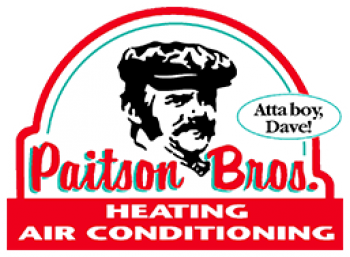The energy use in your office building, apartment, or home may be less efficient than you are aware. Energy efficiency means that less energy is used to perform the same task.
Many New Yorkers are discovering this after the passage of Local Law 95, a law requiring building owners to post the energy efficiency of New York City buildings 25,000 square feet or larger. The law has resulted in raising public awareness on energy efficiency as buildings have had to post their ratings. Many states and countries calculate these ratings but not every building owner may fully understand methods to improve their efficiency and thus their score. Improving this efficiency could not only reduce the emission of global greenhouse gases but can also save money on energy bills for owners and renters as utility costs go down.
So, what exactly makes a building energy efficient?
How ratings are calculated
Standards for energy efficiency can vary by state. However, Energy Star, which works under the U.S. Department of Energy, is a federal baseline for assessing buildings and appliances. Some states, including New York State, base their standards off Energy Star. With these ratings, buildings are compared to others of a similar size and shape. If a building is significantly less energy efficient that other similarly structured buildings, it receives a lower grade. If it is more energy efficient than these other buildings, than it receives a higher grade. Grades are usually on a zero to one-hundred scale with an A to F rating. New York now issues fines for those large building owners who do not post these scores.

via The City of New York: Buildings
How can you improve your energy efficiency and usage?
1. Audit Your Home or Office Space
One way to precisely find out how much energy you might be wasting is to receive an audit on the energy efficiency of your home or office. Professionals in your area can find out exactly where your home is efficient and where it uses excess energy. This allows you to know the exact steps needed to improve any energy inefficiency in your own home or office. The U.S. Department of Energy has advice on finding energy auditors here. Furthermore, Green Business Network (GBN) members such as GreenEcoSavers and Positive Energy provide energy auditing products and services.
2. Check Your Insulation and Sealing
Proper building insulation ensures that you do not use more heating or air conditioning than needed. It prevents the heating or AC from leaking out so that you only use the exact amount of energy needed for the building. Sealing off attics and garages, insulating air ducts, and caulking or weatherstripping air leaks in windows are just some of the ways that individuals can stop the leakage of air. In fact, it would only take half of existing buildings to install thicker insulation in order to avoid 8.3 gigatons of emissions. Maryland Installation Services (GBN) works on sealing involved in window and door replacement and installation.
3. Monitor Your Temperature
After you’ve checked your insulation, it is important to monitor the temperature of your home or office. When you’re not present, setting the temperature to a higher number such as 78 degrees in the summer or 68 degrees in the winter can save up to ten percent on heating and cooling. The goal is to set the internal building temperature to be as similar to the outdoor temperature as possible.
However, note that certain heating systems require different solutions. For example, if the temperature is monitored through a heat pump, it may actually be better to keep a consistent temperature in your home. You can also purchase programmable thermostats that help regulate the temperature and save energy. Positive Energy (GBN) sells a couple of programmable thermostats that can help homes or offices improve their energy efficiency.
4. Upgrade Your Lighting
Roughly 5-percent of the average household’s energy bill is used on lighting. This is especially relevant for marginalized and under-served communities, who tend to face higher energy burdens. Compact fluorescent lamps (CFLs) and light-emitting diodes (LEDs) are the most efficient options when buying light bulbs. CFLs use a third of the energy of a halogen incandescent bulb and LEDs use around 25 to 30 percent less than incandescent bulbs.
In addition, you can save energy by minimizing your lighting usage. When you’re not at home or in the office, remember to turn off your lights. You can also take advantage of natural light during the day.
5. Check Your Equipment and Appliances
Energy efficiency also depends on the type of equipment that the building uses. In a home, this includes appliances such as washers, dryers, and fridges. In an office, this may include computers and printers. Organizations such as Energy Star create certifications that promote energy efficient products with a website full of appliance suggestions. Paitson Bros (GBN) is an example of a heating and cooling company that uses Energy Star qualified equipment.
Furthermore, be sure to activate sleep settings on any printers, copiers, fax machines, etc., and turn off all machinery when not in use.
Refrigerants used in cooling equipment also have significant climate impacts. The most common refrigerants are potent greenhouse gases that often leak out of cooling appliances. You can take action with Green America’s Cool it for the Climate campaign which works to eliminate the use of unsustainable refrigerants and improve cooling efficiency of supermarkets. The U.S. supermarket sector currently emits roughly 45 million metric tons of greenhouse gases every year just through refrigerant leaks.
Several members of the Green Business Network work on energy efficiency and green energy. Check out members such as GreenEcoSavers, Positive Energy, Ecoinstallations, the Sustainability Guys, Paitson Bros, Maryland Installation Services, and more.





